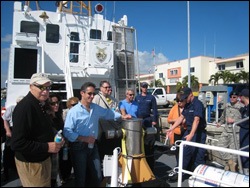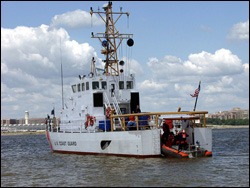JINSA Group Visits Coast Guard Sector Miami
Located in the backyard of the JINSA’s Florida office is the U.S. Coast Guard’s Sector Miami. On January 28, a group of JINSA members took advantage of the opportunity to tour the Sector and meet the men and women who serve the South Florida community, and the nation as a whole. Rear Admiral Norm Saunders, USCG (ret.), a member of JINSA’s Board of Advisors, organized and led the trip. Adm. Saunders retired from the Coast Guard in June 1999 from District 7, in which Sector Miami is located.
Located in the backyard of the JINSA’s Florida office is the U.S. Coast Guard’s Sector Miami. On January 28, a group of JINSA members took advantage of the opportunity to tour the Sector and meet the men and women who serve the South Florida community, and the nation as a whole. Rear Admiral Norm Saunders, USCG (ret.), a member of JINSA’s Board of Advisors, organized and led the trip. Adm. Saunders retired from the Coast Guard in June 1999 from District 7, in which Sector Miami is located.
Coast Guard Sector Miami’s area of responsibility begins about midway through the Florida Keys and extends up the east coast of Florida to Fort Pierce. Sector Miami also works closely with the Royal Bahamian Police Force in enforcing maritime laws and stymieing the flow of illegal drugs and migrants into the United States.
The visit to Sector Miami focused on educating JINSA members about the role the Coast Guard plays within the South Florida community, the Coast Guard District as a whole and in the larger national security picture.
The program began with a welcome from Sector Miami Commander Captain James Fitton. The group was given an overview of the operations and missions of Sector Miami by Lieutenant Junior Grade Christopher Dykeman. Sector Miami’s responsibilities include drug and migrant interdiction, port security, vessel inspections, search and rescue, and environmental response.
 Lieutenant Junior Grade Celina Ladyga and First Class Machinery Technician Dale Stauffer presented the group with information regarding Boarding Teams and boarding procedures. The Coast Guard is permitted to board any vessel operating within U.S. waters for the purposes of inspection; a warrant is not required. Vessels requesting to enter U.S. waters are required to wait offshore for Coast Guard inspection prior to entering. Because of the volume of vessels entering U.S. waters each day, it is impossible for the Coast Guard to inspect each and every vessel.
Lieutenant Junior Grade Celina Ladyga and First Class Machinery Technician Dale Stauffer presented the group with information regarding Boarding Teams and boarding procedures. The Coast Guard is permitted to board any vessel operating within U.S. waters for the purposes of inspection; a warrant is not required. Vessels requesting to enter U.S. waters are required to wait offshore for Coast Guard inspection prior to entering. Because of the volume of vessels entering U.S. waters each day, it is impossible for the Coast Guard to inspect each and every vessel.
To determine which vessels will be boarded, the Coast Guard applies a matrix that takes into consideration the type of vessel, point of departure, declared cargo, etc. Vessels coming to U.S. ports from countries with stringent regulations regarding documentation, vessel safety, and cargo loading are generally considered “safe” to enter U.S. waters and not subject to search. In the case of suspicious vessels, the Coast Guard routinely partners with Customs and Border Patrol in their searches.
Lieutenant Commander Michael Lingaitis explained how the Coast Guard also pairs with Customs and Border Patrol on port security. The Port of Miami is one of the busiest ports in the country and is the cargo gateway to South America. In addition to the commercial cargo traffic, the Port of Miami is also the busiest cruise ship port in the world. With the volume of cargo passing through the port, much like the volume of vessels entering American waters each day, it is impossible to check every one. The Coast Guard (or Customs and Border Patrol) individually inspects less than five percent of the containers that enter American ports. Again, the Coast Guard relies on a matrix that determines the risk of the smuggling of weapons, people or drugs.
Drug and migrant interdiction is a key concern in the United States generally, and in South Florida particularly. Smugglers frequently use the Bahamas to conduct their clandestine operations. Calm seas and close proximity to the Florida coastline make the Bahamas a desirable stopover point from elsewhere in the Caribbean to South Florida. The relationship that the Coast Guard maintains with the Bahamian government is critical in interdicting drugs and migrants prior to entry into the United States.
The Coast Guard visit also gave the JINSA group the opportunity to more fully understand the “Wet Foot/Dry Foot” policy, which applies to Cuban migrants only. Essentially, if a Cuban migrant makes it to U.S. soil, they are granted asylum and can become U.S. citizens. If they are captured at sea, they are returned to Cuba. Non-Cuban migrants who are interdicted, whether on shore or at sea, are held for processing and returned to their country of origin. In an effort to prevent repeat interdictions, the Coast Guard gathers and records biometric information on captured migrants. This information is maintained in a database accessible by those at sea via the Command Center in Miami. This information not only allows the Coast Guard to identify repeat offenders, but also has led to the arrest of individuals who are wanted for crimes either in the United States or their countries of origin.
The Sector Miami Command Center plays a crucial role in the interdiction process by monitoring maritime activity, coordinating assets, and providing information from law enforcement databases. The center staff, on duty 24 hours a day, 7 days a week, closely monitors everything from weather conditions to port traffic to asset location. Sector Miami relies members of the Coast Guard Auxiliary to augment the Command Center staff because of its around-the-clock operations.
 The Coast Guard Auxiliary is the volunteer arm of the United States Coast Guard made up of 30,000 men and women. Coast Guard Auxiliary members serve in all 50 states as well as Puerto Rico, the Virgin Islands, American Samoa and Guam. Primary responsibilities of the Auxiliary include boater safety instruction and checks, harbor and pollution patrols, standing communication watches and assisting during mobilization exercising. Members of the Auxiliary volunteer not only their time but also their assets, as many members of the Auxiliary utilize their own vessels for patrols.
The Coast Guard Auxiliary is the volunteer arm of the United States Coast Guard made up of 30,000 men and women. Coast Guard Auxiliary members serve in all 50 states as well as Puerto Rico, the Virgin Islands, American Samoa and Guam. Primary responsibilities of the Auxiliary include boater safety instruction and checks, harbor and pollution patrols, standing communication watches and assisting during mobilization exercising. Members of the Auxiliary volunteer not only their time but also their assets, as many members of the Auxiliary utilize their own vessels for patrols.
The JINSA group was able to go aboard the newly commissioned 87-foot Diamondback. The Diamondback is the 69th Marine Protector-class patrol boats in Coast Guard service. The generous assistance of several Auxiliarists and their boat enabled the JINSA group to observe the Diamondback’s crew carrying out a boarding exercise on a private vessel in the Port of Miami.
One of the most advanced features of the Marine Protector-class boats design is its capability to launch and recover small boats astern through a water level doorway. Each 87-foot hosts a Zodiac Hurricane 18-foot rigid inflatable boat. While launching and recovering small boats at sea always will represent some risk, particularly at night and in rough weather, the Marine Protector’s stern launch system is widely considered to be a tremendous improvement in performance and safety.
Captain Peter Brown presented the Coast Guard’s acquisition plans for additional patrol boats, medium endurance cutters, helicopters and airplanes. A good portion of the Coast Guard’s fleet of helicopters, aircraft and larger ocean-going vessels is quite old and manpower intensive to operate. These vessels require excessive maintenance, which retards readiness and increases life cycle costs.
Captain Glenn Grahl explained that a sizable Coast Guard detachment operates in the Gulf out of Bahrain guarding oil platforms and terminals. The Coast Guardsmen of the detachment, which Grahl formerly commanded, also are frequently first responders to lesser incidents in the Gulf from ships in distress to medical emergencies.